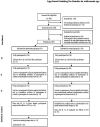Effects of an App-Based Physical Exercise Program on Selected Parameters of Physical Fitness of Females in Retirement: A Randomized Controlled Trial
- PMID: 35317213
- PMCID: PMC8934397
- DOI: 10.3389/fphys.2022.821773
Effects of an App-Based Physical Exercise Program on Selected Parameters of Physical Fitness of Females in Retirement: A Randomized Controlled Trial
Abstract
Modern technologies enable new options in the delivery of physical exercise programs. Specially designed app-based programs can be used to help older people in particular to integrate physical exercise into their daily lives. This study examines the influence of an app-based physical exercise program on selected parameters of physical fitness, such as muscular strength, balance, and flexibility. The women (n = 110) were on average 65.3 (± 1.5) years old and, compared to age-specific norm values, healthy. The 14-week intervention consisted of an app-based, unsupervised physical exercise program, in which the exercise frequency and duration of sessions were self-selected. The physical exercise program consisted of simple, functional exercises such as arm circles, squats, lateral raises. The participants were provided with an elastic resistance band and an exercise ball allowing them to increase exercise intensity if needed. Participants were randomly assigned to intervention group (IG) and control group (CG). 71% of the IG used the physical exercise program at least 1.2 times per week, whereas 25% of the IG showed usage rates above four times per week. Significant effects were found in the domains of muscular strength and flexibility. While IG could maintain their performance in isometric muscular strength tests and increased their flexibility, CG faced a decrease in those parameters. Thus, this app-based physical exercise program had positively influenced muscular strength and flexibility in women over 60 years of age.
Keywords: AAL; active aging; digital; flexibility; healthy aging; strength.
Copyright © 2022 Jungreitmayr, Kranzinger, Venek and Ring-Dimitriou.
Conflict of interest statement
CK and VV were employed by company Salzburg Research Forschungsgesellschaft mbH. SJ is the owner of MyBodyCoach. The remaining authors declare that the research was conducted in the absence of any commercial or financial relationships that could be construed as a potential conflict of interest.
Figures


References
-
- Ayala F., Sainz de Baranda P., De Ste C. M., Santonja F. (2012). Reproducibility and concurrent validity of hip joint angle test for estimating hamstring flexibility in recreationally active young men. The. J. Strength Cond. Res. 26, 2372–2382. doi: 10.1519/JSC.0b013e31823db1e2, PMID: - DOI - PubMed
-
- Barbosa A. R., Santarém J. M., Jacob Filho W., Marucci M. D. F. N. (2002). Effects of resistance training on the sit-and-reach test in elderly women. J. Strength Cond. Res. 16, 14–18. PMID: - PubMed
LinkOut - more resources
Full Text Sources

